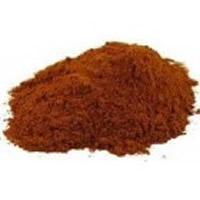Bloodroot Purchase & Information

Alternative Names
Bloodwort, Coon Root, Indian Red Paint, Indian Plant, Pauson, Red Puccoon, Red Indian Paint, Red Root, Sang de Dragon, Sang-Dragon, Sanguinaire du Canada, Sanguinaire, Snakebite, Sanguinaria and Sweet Slumber, Tetterwort CAUTION: Please refer to separate listing for Tormentil, Knotweed, Yarrow
Scientific Name
Sanguinaria Canadensis
Why Do People Use Bloodroot?
Bloodroot powder is utilized orally as a cathartic, as an emetic, expectorant and antispasmodic. Additional oral uses of Sanguinaria Canadensis include its use as a general tonic, for asthma, bronchitis, laryngitis, croup, deficient capillary circulation, pharyngitis, rheumatism, nasal polyps, cancer (Fell technique), warts, in fever and as dental analgesic. croup, laryngitis, pharyngitis, deficient capillary circulation, nasal polyps, rheumatism, warts, cancer (Fell technique), dental analgesic, fever, and as a general tonic.
For topical consumption, Sanguinaria Canadensis is used as debriding and irritant agent.
For Dentistry purpose, bloodroot powder is used to remove or reduce plaque.
Is It Safe To Use?
Likely safe - For oral purpose, it should be used for short term and appropriately.
Likely Unsafe - Sanguinarine is observed when over dosage of bloodroot is used orally.
Regarding safety of bloodroot there is insufficient reliable information available.
Likely Unsafe in Pregnancy - Avoid oral consumption of bloodroot powder in pregnancy.
Likely unsafe in Lactation - Avoid oral consumption of Sanguinaria Canadensis in lactation.
How Effective Is Bloodroot?
Regarding effectiveness of bloodroot powder, there is insufficient reliable information available.
How Bloodroot Works?
Rhizome is the most effective part of Sanguinaria Canadensis. Antimicrobial, sanguinarine, anti-inflammatory, antifungal and antihistamine activities have been observed in constituents of isoquinolone alkaloid. Sanguinary negative ions have the ability to bind oral plaque and could exert antiplaque activity. It also appears to have cardiotonic actions, likely by producing a positive inotropic effect and preventing Na/K-ATPase activity.
What Are The Side Effects /Adverse Reactions of Bloodroot?
Oral consumption of bloodroot powder may be the reason of vomiting, nausea issues, narcosis and minor central nervous system (CNS) depression. Some other issues like shock, hypotension, glaucoma and coma have been observed particularly with high doses.
Fresh bloodroot causes some skin diseases like contact dermatitis or irritation problems. Moreover, eyes and mucous membranes contact should be avoided due to its irritant properties.
How Bloodroot Interacts With Other Herbs and Supplements?
Not known.
How Bloodroot Interacts With Drugs?
Not known.
How Bloodroot Interacts With Foods?
Not known.
How Bloodroot Interacts With Lab Tests?
Not known.
How Bloodroot Interacts With Diseases and Conditions?
Gastrointestinal (GI) Irritation - Bloodroot powder may cause irritant behaviors in GI tract and is contraindicated in patients with inflammatory or infectious gastrointestinal conditions.
Glaucoma - Treatment of glaucoma could be affected by Sanguinaria Canadensis. So, its dosage should not exceed as prescribed by physician.
What Should Be the Dose/Administration of Bloodroot?
ORAL consumption of bloodroot rhizome is 60 to 500mg thrice a day.
In liquid for, its normal dosage, in the form of 1:1 extract in 60% concentrated alcohol, is 0.06-.3mL used thrice every day.
The dosage of an extract, having 1:5 ratio in 60% concentrated alcohol, is 0.3-2mL and is used thrice each day.
TOPICAL No typical dosage.
Emetic Dose for emetic dosage, 1-2 mL of the liquid extract; 1-2 g rhizome; 1:1 ratio in 60% alcohol; 2-8 mL of the tincture and 1:5 ratio in 60% alcohol have been used.
Comments
During the period of mid-1800’s bloodroot extracts were utilized for the treatment of breast tumors as in Fell Technique. Its scientific name is Sanguinaria Canadensis.
General Certificate of Analysis (COA)
Specification sheet links below are a standard copy of the COA less the batch or lot number and manufactures dates. Specification sheet can be dated and should only be considered as a general information. Please contact and request an up to date COA if needed for specific updated information before placing order by filling out the contact form with product name and SKU number. If ordering quantities of twenty five kilos or more contact for availability.
